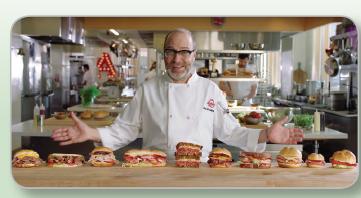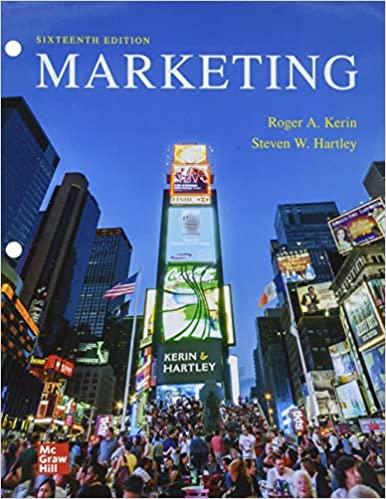Were an advertising agency for companies who want to outsmart the competition, not outspend them, explains Andy
Question:
“We’re an advertising agency for companies who want to outsmart the competition, not outspend them,” explains Andy Rhode, director of media at Fallon Worldwide. “People think about Fallon as a creative agency, and for us that’s just how we get to success,” he adds.
In fact, Fallon’s web page proclaims, “We believe that creativity is the last legal means to an unfair advantage”!
THE COMPANY Fallon Worldwide was founded by Pat Fallon and four other partners who wanted to challenge the prevailing practices in the advertising industry. According to Fallon, “our aim was to build a culture of respect, transparency, optimism, honesty, fun, resilience, and generosity and by so doing, give ourselves a competitive advantage.” The culture created a unique community of advertising professionals and led to a philosophy they called “family as a business model,” says Rhode. The approach was an immediate success as the agency attracted national clients such as The Wall Street Journal, Ralston Purina, Lee Jeans, Timex, and Rolling Stone magazine. Fallon went on to win the Agency of the Year award from Ad Age magazine—three times!
The focus on creativity influences all aspects of the agency.
“We’ve always positioned ourselves as a creative idea-led agency, and I think that informs all of our disciplines,”
says Rhode. “We think about creative creatively, and we also think about strategy creatively,”
he explains. Fallon has offices in Minneapolis, New York, and London. Each office utilizes a straightforward structure. According to Rhode, “we have a creative department that is copywriters, we have a production department that truly produces a lot of what we make, we have a media department composed of media planners and buyers, we have a strategy department where the research really lives, and then we have an operations arm that’s finance, accounting, and billing.”
Today Fallon is owned by a holding company called Publicis Groupe, which also owns Leo Burnett, Saatchi & Saatchi, Marcel, Starcom, Spark, Digitas, and several other agencies. “The value of a holding company like Publicis is the technology they are able to bring, and the scale in terms of research,” says Rhode. “For global

pitches, there is also the size we are able to tap into, so we certainly look at Publicis as a big advantage for us.”
DEVELOPING AN ADVERTISING CAMPAIGN AT FALLON Consumers who simply see an online video or a print ad or an endorsement from an influencer typically don’t understand the many hours of work that went into an advertising campaign. At Fallon, the sequence of activities generally includes three steps: planning, implementation, and evaluation.
Planning “We start with the planning department, and from there we engage creative, we engage account people, we engage production, and we just start working,” says Jordan Hoffarber, group account director at Fallon. “Every campaign is usually rooted in some sort of human truth and that human truth has to come out of research, so research plays a big role.” In fact, research is essential to understanding the customer journey and how advertising might influence prepurchase, purchase, and postpurchase activities. The planning process also involves engaging the client to ensure a mutual understanding of the campaign objectives.
Account managers are responsible for coordinating the planning activities. “As an account manager you are responsible for leading our client’s business and leading our internal creative business. That means that we are not just about client service, but we’re about business leadership. What are the objectives? How are we going to achieve those objectives?
What are the budget parameters? And then how do we get the campaign made and out into the world? Account managers lead that process and touch every single part of that process,” explains Hoffarber.
The research, strategy, and objectives help the creative team create the messaging. “As creatives it’s our job to decide what is most interesting or compelling, and how we deliver that nugget of truth about a brand or a product,” says Charlie Wolff, creative director at Fallon.
The creative department consists of copywriters, art directors, and technologists. According to Wolff, “art directors are typically considered to be more conceptual, copywriters are ultimately responsible for the words, and technologists enlighten us to all the things that transcend words and pictures.”
Implementation The creative team also works with the agency’s media planners and buyers to select and schedule the media to deliver the message to the target audience. “We like to be able to work hand-in-hand with media,” says Wolff.
“Especially with the way that people consume media today, it is always best when media is brought in as soon as possible in the process.” Media include many alternatives such as TV, print, social, and events. While all advertising competes with messaging from other brands, social media messages have a unique challenge. “Your competitors on social are no longer your competitors in your category,” explains Wolff. “Your competitors are everything in someone’s social feed, it’s whatever’s happening in the political landscape, a friend’s baby, or any other thing that is happening in the news.”
Evaluation The agency and its client want to know if a campaign is accomplishing its objectives. According to Hoffarber, “Every campaign is supposed to drive results, and results at the end of the day should be sales. However, there are a lot of other metrics that we measure, things like click-through rates, and awareness, and shareability”
(how many times a message was shared with friends).
Evaluation of the various measures of results allows Fallon to work with its clients to fine-tune messaging and media selection for the campaign.
DEVELOPING THE ARBY’S “WE HAVE THE MEATS” CAMPAIGN Arby’s executives came to Fallon with a simple question:
What is Arby’s reason for existing? Research indicated that Arby’s was best known for its roast beef sandwich. However, the emphasis on roast beef was also limiting the number of new customers. Fallon called this “the roast beef riddle.” “How often is somebody in the mood for a roast beef sandwich?” asked Charlie Wolff. “Not very often.”
So, the campaign development process began with a brief description of their challenge: change the positioning of Arby’s from a place for just roast beef to a place where everybody can find something to eat. The general objective of the campaign was to expand consumer interest from a single product, roast beef, to all the other proteins that were available in Arby’s sandwiches. With that as a starting point, the research, strategy, and creative teams began a discussion that led to many ideas on a massive whiteboard. Charlie Wolff explains the

process: “In the case of Arby’s, deciding on the specific message was a collaborative thing. We were sitting in a conference room and we would talk about each of the ideas on the board. Then we put stickers on the ones we liked and asked, ‘Why do we like this?’ and ‘Why does this feel right?’” At the end of the process the team selected the tagline “We Have the Meats”!
The creative and media teams then invited the Arby’s executive chef to Fallon. He set up in the Fallon kitchen with the different types of proteins and started slicing the meat. Rhode observes, “That’s interesting to see in its whole form because it makes me trust that the food you’re making is legitimate.” As a result the Fallon team decided to kick off the “We Have the Meats” campaign with a television ad showing a man in a chef’s coat slicing the meats available in Arby’s sandwiches. “We focused on their product,” says Rhode, “and I think it found a really special tone of voice that was funny without being a joke.”
The assessment phase of the Arby’s campaign is ongoing.
Different types of sandwiches and sandwich names are tested in separate markets. In addition, promotions such as Arby’s offer of a “One-day $6 trip to Hawaii” to eat Arby’s sandwiches supplement the “We Have the Meats”
campaign. Arby’s and Fallon also monitor daily sales reports, which indicate the campaign is a huge success!.........
Questions
1. What is Fallon’s philosophy regarding its business model and culture?
2. Describe the steps Fallon uses to develop a campaign for a client.
3. What factors contributed to the success of the Arby’s campaign?
4. What skills and interests will help future advertising professionals?
Step by Step Answer:






